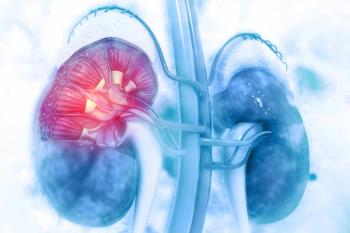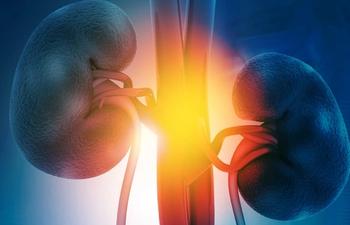
Clinical Scenario 2: Favorable-Risk Metastatic Renal Cell Carcinoma
Switching focus to a second clinical scenario, key opinion leaders on metastatic renal cell carcinoma discuss the treatment landscape for favorable-risk disease.
Episodes in this series

Transcript:
Chung-Han Lee, MD, PhD: Shifting gears a little bit, we have our second case. This is a different patient, 63 years old, presenting to her primary care doctor for an annual checkup. Then she mentioned that she’s been a little bit more fatigued and then she’d noticed some discomfort in her right side from a past medical history standpoint, fairly unremarkable. Just the patient with a little bit of asthma, but well controlled on medication. She’s a “never smoker.” Occasionally drinks. Just a little bit of social alcohol. Given this ongoing persistent pain, they end up doing a CT scan to evaluate and then they notice that she has a 6-centimeter right-sided renal mass, which she ends up getting a radical nephrectomy and confirms that this was a clear cell renal cell carcinoma [ccRCC]. Afterward, given the fact that it was limited-stage disease without any high risk features, the patient underwent the elective active surveillance. About 18 months after surgery, so about a year and a half, she comes back, and from routine follow up she’s noted to now have a couple of small nodules within the liver. Then because it’s been more than a year, a biopsy was done and did confirm that this was metastatic RCC. Again, the labs are normal and putting her in that favorable risk sort of category. Thinking about it from a risk stratification sort of standpoint, checking all the boxes of not having any of those risk factors that would make them IMDC [International mRCC Database Consortium] intermediate- or poor-risk disease, as we mentioned before—a later time of recurrence, the absence of any lab abnormalities, and a very good robust performance status. Given that, there’s again, multiple treatment options in this sort of setting with multiple TKI [tyrosine kinase inhibitor]/IO [immuno-oncology] regimens that are both FDA-approved and also recommended as preferred regimens by the NCCN [National Comprehensive Cancer Network] considering the combination of axitinib [Inlyta] plus pembrolizumab [Keytruda], considering cabozantinib [Cabometyx] plus nivolumab [Opdivo], also considering lenvatinib [Lenvima] plus pembrolizumab. All of which are fairly reasonable options in that sort of setting. Certainly, the combination of ipilimumab [Yervoy] plus nivolumab is not per label FDA-approved in that sort of setting. Christine, for this patient that we’re thinking about starting on a TKI/IO regimen, such as lenvatinib/pembrolizumab, how often are you probably seeing these patients?
Christine Anderson, NP: These patients are receiving active treatment, and they’re receiving the immunotherapy about every 3 weeks, so we would certainly see them for their visits just before we proceed with any more infusions to assess their side effects and tolerability. We certainly want to get updated labs before each infusion also while they’re on the TKIs too, just to make sure everything [is] within range to continue their therapy or in case we need to modify any dosing or anything like that. But it certainly is on about every 3 weeks or at least a month that we’re seeing them in clinic to evaluate them.
Chung-Han Lee, MD, PhD: How about in between visits? How do you like the communication to go?
Christine Anderson, NP: Certainly things come up in between visits and we want to stress to them that things don’t have to wait until we see them in person. So it’s important to let them know. I think a lot of them find the patient portal very useful, even just for routine questions, but I do think it’s important that if it’s something new or more concerning side effect or symptom that they do call because we want to make sure we address that right away. Whether they need to come in to see us or be seen in an emergency department or in urgent care or whatnot. I think it’s important that they do call us if it’s a new or concerning symptom.
Chung-Han Lee, MD, PhD: I think that’s incredibly important to remind the patients, especially upfront because they’re dealing with this for the first time. They don’t necessarily know what’s important, what’s not important. To have that bidirectional communication and knowing when something is OK for electronic communication and when they need to talk to a live person so that this can be acted upon immediately.
Christine Anderson, NP: Exactly. I think I always tell them even the littlest thing, even if they’re not sure, just to let us know. We’d rather know about it than not know about it.
Chung-Han Lee, MD, PhD: Then let’s say the patient comes to you with some symptoms. What’s your threshold for saying that we should probably think about escalating some of the questions?
Christine Anderson, NP: I think it depends on, obviously, what it is. We’ve talked about things like diarrhea and blood pressure. Certainly, if blood pressure is a hypertensive crisis, they need to go to an emergency department. But there are other things that cancer patients are at risk for. So sometimes whether it’s new onset shortness of breath or things like that. Do we have to rule them out for blood clots or whatnot? Then those things have to go to a symptomatic care clinic that we use, or an emergency department. Sometimes if new pain or things like that occur, it just may prompt us to get imaging a little bit sooner rather than later, but those I think are the big things.
Chung-Han Lee, MD, PhD: I think that’s very incredibly important—thinking about the timing of assessing whether or not the drugs are working. One of the things I tell the patients is if you’re feeling great, then I probably will do your scans on an every 3-month sort of basis. Certainly, if you have anything that makes me concerned that you might be progressing, then I certainly would want to move that imaging up because want to be dogmatic about this screening sort of regimen.
Christine Anderson, NP: Yes. Exactly.
Chung-Han Lee, MD, PhD: Especially for people with favorable-risk disease, the outcomes are often quite good. We see a lot of dependence on the VEGF-targeted signaling pathways, so that inclusion of a TKI in that setting often can lead to more robust responses and longer durability. Unfortunately, at least as of 2023, we do still have quite a few patients [who] end up progressing. Then at the time of progression, there often is a question of what’s the appropriate next drug that we’d consider in that setting? I think a lot of that is going to end up depending on what was the regimen used in the first-line setting. So, for this patient, they started out with lenvatinib plus pembrolizumab. Certainly, we wouldn’t give lenvatinib again. Cabozantinib would certainly be a very reasonable option for that setting. Axitinib would also be reasonable. A lot of that discussion is really based off of the robustness of the patients and trying to reassess what we’re hoping to do.
Transcript edited for clarity.
Newsletter
Stay up to date on recent advances in the multidisciplinary approach to cancer.























































































